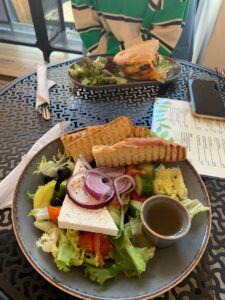Our experience of food is inherently synaesthetic, through our use of taste, sight, smell, sound, and touch (Korsmeyer and Sutton 2011; Sutton 2010), but social media allows the experience of food to reach further – through virtual synaesthesia (Rogowska 2011). Drawing on my own experiences of using Instagram, I will explore how the sharing of food images has become a powerful tool in the creation of individualised sensory experiences.
Virtual synaesthesia is the experience of sensations, such as taste, as a result of stimulation to one sense, such as vision, whilst in the virtual world (Rogowska 2011). I argue that this has become more common in recent years as a result of the increasing popularity in sharing what we are eating with our Instagram follows by posting images of aesthetic plates of food. Whilst I don’t post these images online, I sometimes take pictures of what I am eating when I am out with friends (figures 1 & 2). These photos follow the typical Instagram trend of showing the plate of (generally) aesthetically presented food, often in addition to sharing who you are eating with.

Figure 1. An ‘Instagram lunch’, with enough detail to portray the range in tastes and textures in the salad to viewers. (Author’s own image 2022)

Figure 2. An ‘Instagram brunch’. The food is presented in an aesthetic way, suitable for sharing with Instagram followers and stimulating virtual synaesthesia experiences. (Author’s own image 2022)
Although we can’t share the taste of food with others, Instagram provides a sharing avenue for synaesthetic experiences (Caroni Schweitzer Gil, n.d.). Seeing images of well-presented food triggers our taste buds and often ignites a taste experience, where we have a strong sense of the flavours being depicted in the photo. This allows for the creation of a community through food, as despite not physically eating what the original Instagram user did, those seeing the image are now more engaged in the eating experience through the creation of flavours in their own mouths.
I find the virtual synaesthesia experience more intense with some foods over others. An image of a roast dinner, sometimes sent to me by family members, gives a strong taste in my mouth as I have a true understanding of what it would taste like. This often initiates a strong craving, which I believe to be due to my connections between roasts and home. The sense of comfort created by the synaesthetic taste of a roast dinner (Caroni Schweitzer Gil, n.d.) makes me want to eat one in order to satisfy this feeling of comfort and feel more homely.
It’s worth noting that Instagram allows images to be shared on a global scale, but the understanding of what the photographed food tastes like is likely to vary between cultures (Farrell 2020), depending on their own taste expectations. Whilst European gastronomy focuses on pairing foods with shared flavours, Asian cooking avoids mixing similar flavours (Ahn et al. 2011) so our individual understandings of what different dishes taste like vary significantly. For example, an Asian Instagram user may not experience the same taste synaesthesia from a typical Western Instagram brunch photo as those from Europe would, due to our different cultural understandings and experiences of flavour.
Word count: 500
Bibliography
Ahn, Y-Y., Ahnert, S., Bagrow, J., Barabasi, A.L. (2011) ‘Flavor network and the principles of food pairing’ Scientfic Reports, 1(197) pp. 1-7
Caroni Schweitzer Gil, A. (n.d.) ‘Sharing Food While Being Apart: Synaesthesia in the time of COVID-19’, Sixth Sense Abcderium. [Online] Available at: <https://sixthsensereader.org/about-the-book/abcderium-index/synaesthesia/> [Accessed 27 March 2022]
Farrell, B. (2020) ‘Virtualizing our mouths: The sensorium and Instagram imagery’, International Journal of Food Design, 5(1-2), pp. 113-123
Fleming, A. (2013) ‘The geography of taste: how our food preferences are formed’, The Guardian, 3 September. [Online] Available at <https://www.theguardian.com/lifeandstyle/wordofmouth/2013/sep/03/geography-taste-how-food-preferences-formed> [Accessed 28 March 2022]
Korsmeyer, C. and Sutton, D. (2011) ‘The sensory experience of food’, Food, Culture and Society 14(4), pp. 461-475
Rogowska, A. (2011) ‘Categorization of Synaesthesia’, Review of General Psychology, 15(3), pp. 213-227
Sutton, D. E. (2010) ‘Food and the Senses’, Annual review of anthropology 39(1), pp. 209-223



Leave a Reply